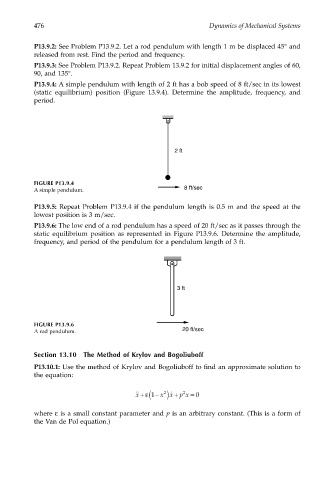Page 495 - Dynamics of Mechanical Systems
P. 495
0593_C13_fm Page 476 Monday, May 6, 2002 3:21 PM
476 Dynamics of Mechanical Systems
P13.9.2: See Problem P13.9.2. Let a rod pendulum with length 1 m be displaced 45° and
released from rest. Find the period and frequency.
P13.9.3: See Problem P13.9.2. Repeat Problem 13.9.2 for initial displacement angles of 60,
90, and 135°.
P13.9.4: A simple pendulum with length of 2 ft has a bob speed of 8 ft/sec in its lowest
(static equilibrium) position (Figure 13.9.4). Determine the amplitude, frequency, and
period.
2 ft
FIGURE P13.9.4
A simple pendulum. 8 ft/sec
P13.9.5: Repeat Problem P13.9.4 if the pendulum length is 0.5 m and the speed at the
lowest position is 3 m/sec.
P13.9.6: The low end of a rod pendulum has a speed of 20 ft/sec as it passes through the
static equilibrium position as represented in Figure P13.9.6. Determine the amplitude,
frequency, and period of the pendulum for a pendulum length of 3 ft.
3 ft
FIGURE P13.9.6
A rod pendulum. 20 ft/sec
Section 13.10 The Method of Krylov and Bogoliuboff
P13.10.1: Use the method of Krylov and Bogoliuboff to find an approximate solution to
the equation:
2
˙ x p x = 0
˙˙ x + ( ε 1 − x ) + 2
where ε is a small constant parameter and p is an arbitrary constant. (This is a form of
the Van de Pol equation.)

